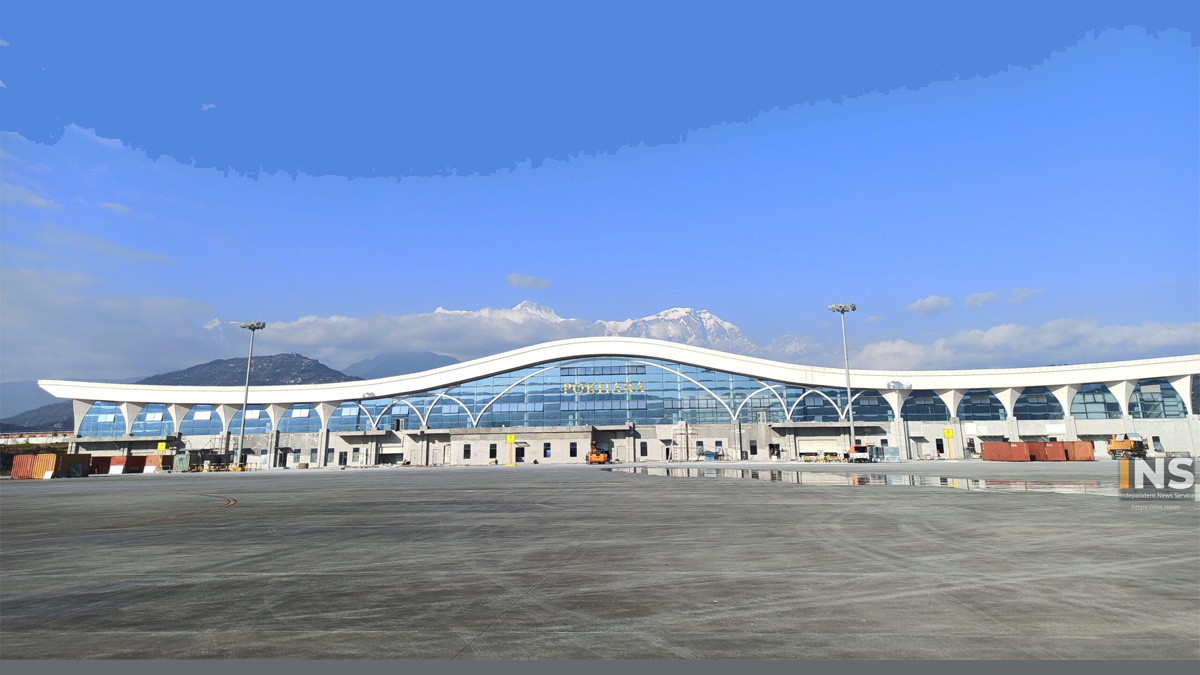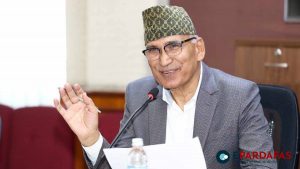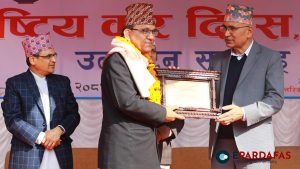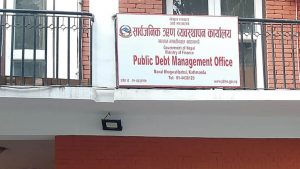
Is Pokhara International Airport becoming a Chinese ‘debt trap’ ?

It has been six years since the foundation stone of Pokhara International Airport was laid on the 1st of Baisakh, 2073 BS. Built with an investment of 22 billion, Pokhara International Airport is now awaiting operation.
At present, 98 percent of the work is reported to be completed, and it is scheduled to become operational from January 1, 2023. It remains to be seen whether there will be an international flight at Pokhara International Airport on January 1, 2023. According to the contract with the Chinese company, the work was initially expected to be completed by June 2078, but due to Covid, the timeline was extended.
While the construction work of the airport was not completed in Chaitra 2078, Chinese Foreign Minister Wang Yi, during his visit to Nepal, handed over the keys to the airport to Foreign Minister Narayan Khadka. Although Nepal has taken over the key to Pokhara Airport from China, a serious question has been raised regarding how its operation and international flights can be sustained without regularity.
Airport Operations: A Present Problem
Land acquisition work began for the first time in 2032 BS for the construction of Pokhara International Airport. An international airport has been constructed on an area of 3,899 ropani in Chauthe, Pokhara, with the help of loans and grants from China’s Exim Bank. After the agreement between the Civil Aviation Authority and the Chinese contractor company China CAMC Engineering Company Limited, the construction work of Pokhara International Airport began.
Now, only 2 percent of the work is left, according to Vinesh Munkarmi, head of the airport project. He mentioned that most of the physical infrastructure of the airport has been completed. Munkarmi said, “It is considered to be completed only after a 2 percent calibration flight (test flight from the airport).” The project chief added that although only 2 percent of the work is left, there are still tasks such as cutting Rithepani Danda, landfill relocation, fuel storage, canal, and sewage management.
Rithepani Danda: An Obstacle Due to Lack of Prior Study
While investing billions in Pokhara International Airport, due to a lack of a prior study about the location, Rithepani hill became an obstacle. The process of felling the hills has started with the approval of the Ministry of Forestry. The completion time of the airport has been extended due to this. The subject of Rithepani Danda was not mentioned in the EPC contract, i.e., Engineering Procurement Construction Contract.
It was only after the construction of the airport started that the Rithepani hill on the eastern side appeared as an obstacle for the flight. This mountain has to be cut up to 40 meters for the operation of international flights. Now, after giving compensation, hill cutting has started. There are 600 trees in that area.
All these are going to be cut for the construction of the airport. Kedar Baral, Divisional Forest Officer of Kaski, Divisional Forest Office, says, ‘After studying the supplementary environmental impact assessment, the department has given approval. We have also ordered cutting. Now they have to start their process and start cutting. There has been an agreement to pay compensation for tree cutting and hill maintenance.
When cutting trees in the government forest area, the project has to pay the forest department’s name instead. There is also a provision that for cutting one tree, 10 trees should be planted, and they should be grown for 5 years and handed over. 6000 trees have to be planted as compensation for cutting down 600 trees of Rithepani hill.
Landfill Site Not Relocated Due to Lack of Readiness of the Metropolis
The main obstacle to the airport is the landfill site of Pokhara. The topic of shifting the landfill site near the airport has already been raised. A new landfill site has not been designated due to a lack of interest and readiness in this matter. Birds are abundant at landfill sites. The area is especially home to vultures and vultures.
Although the area between Ward No. 16 and 20 of Pokhara was chosen for the new landfill site, after the locals protested, the discussion continued to build it in Pokhara 33. There is also a situation where locals have protested. In this case, even if it is in the form of a new or an alternative, the issue of where to relocate the landfill site has not yet been decided.
Due to this, the operation of the airport is getting delayed. Airport project chief Munkarmi said that flights will not be safe until the landfill site is relocated, putting pressure on the metropolis by holding several meetings. According to him, after the calibration is successful, the project will transfer to the airport. After that, it will be necessary for the metropolis to relocate the landfill as soon as possible for the continuation of flights at the airport. He is assuring that a meeting is also being held with the new mayor.
Pokhara’s Paragliding Barrier: The ‘No’ Stance of Not Leaving
After the opening of Pokhara International Airport, the Civil Aviation Authority has ordered the relocation of the paragliding flight area, as it is seen to obstruct international flights. Nepal Air Sports Organization ‘NA’ has taken a stand with suggestions to organize paragliding in Pokhara itself.
President of the organization Sunil Bhattarai said, ‘Paragliding, which has become an important activity for Pokhara’s tourism, should not be displaced from here. According to the information given by President Bhattarai, Yogesh Bhattarai, when the Minister of Tourism said that he would study the feasibility of paragliding in Pokhara along with the airport, but with the change of minister, that matter did not move forward either. After covid, there are now 300 to 500 daily flights to Pokhara Sarangkot.
After the operation of the airport, the future of paragliding in Pokhara is divided into two groups. Paragliding professionals and people associated with it are saying that the displacement of paragliding from Pokhara will have a direct impact on Pokhara’s tourism, while others say that tourism should not be reduced only in small Pokhara, but the possibility of paragliding in other districts of Gandaki Province, Syangja, Tanahun, should be shifted as an alternative.
Need for More Air Access to Sustain
In Nepal, 90 percent of international flights enter Kathmandu via Simara. Mechi has been designated as an entry route for flights from China to the Everest region and for flights from Bhutan. There are 3 entry routes into Nepal. Most of the flights in Nepal come from the west. Therefore, there is a need to increase the air access route in Nepal.
India should give permission to Nepal for this. Nepal had proposed to India to give seven entry points from East to West Mahendranagar. Discussions with India have only been prolonged, and the squeeze has not been released. For Pokhara and Gautam Buddha Airports, it is necessary to enter from Nepalgunj and Mahendranagar. Since there is no permission for air entry, the ship that has to come through Simra has to use a detour route to reach Pokhara and Gautam Buddha Airport, which is already operational. This leads to higher flight costs, and as soon as the flight costs increase, the cost of the ship increases, affecting the passengers.
So that passengers can choose the cheapest flight. As a result, the Pokhara airport may reach a situation where it cannot compete in the international market. If Nepal could use its skies, it could get crores of royalty from foreign airlines, but if that is not possible, the possibility of the newly constructed international airport going into debt increases in the future.
The International Airport in Pokhara: Need or Political Interest?
Sociologist Bishwa Sigdel, who has been expressing his opinion about Pokhara Airport since the beginning, said that if the construction work should be started only by signing an agreement on the air access route with the neighboring country India, the country may sink into debt if it is rushed for political and commission benefits.
He said, “When investing billions, we should have made diplomatic efforts with India to get access, but due to political benefits and the interests of the commission, these issues were not prioritized.” If we don’t get an entryway, now we can only carry debt to the country.’
He said that India will continue to argue for the entry route citing economic and security reasons and said that Nepal can bring the entry route only by using strong diplomacy. He claimed that if Pokhara International Airport gets access to Kanchanpur, the financial burden of the airport and airlines will be reduced and the royalties will be sustainable.
Sigdel, a social personality of Pokhara, said that if there is willpower, the current problems for the operation of the airport can be solved within a month.
According to him, these problems are not big if Pokhara metropolis only shows willpower. If the municipality shows readiness for the landfill, it can be removed in 15/20 days. It took that much time to get the hill cutting permission. Forests could have been cut within 24 hours for the national pride plan, but it was not said. Because he understands that their ambition is to have an airport here, to carry debt to the people.
Sigdel said that even though the airport brought to the heart of Pokhara is seen as development work, it will damage the beauty of Pokhara. He said, ‘It seems that there will be two losses. A physical damage, most shipwrecks occur during take-off and landing. Being in the middle of the city, if an accident occurs, the physical damage may be more. Another is a natural beauty. The tourist town of Pokhara becomes noisy. Because of the sound, the birds can’t catch the baby, so they can move.
He said that even in the big tourist cities of the world, they have flourished even though there is no international airport and that Nepal should study such international practices and start the project only.
Currently, only Jazeera Air is flying at Gautam Buddha International Airport in Lumbini, built at a cost of more than 8 billion. In order to attract airlines, the government has decided to give a 100 percent discount on landing and rest charges. Due to the discount, international airlines may come to the airport for some time, but as soon as the discount is not given, it is more likely that the airline companies will not fly because they cannot afford the expenses.
Therefore, the future of Pokhara International Airport, which is following this path until the permission of the air access route, is also uncertain.













Comments